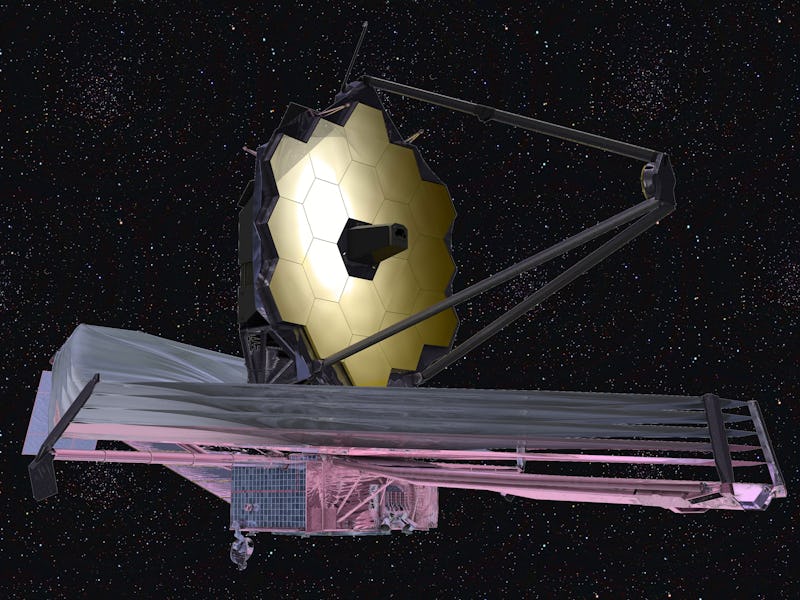Swish! Webb Telescope needs to hit these major milestones next to achieve pivotal “first light”
NASA's newest telescope is rounding the final corner to first light.

Astronomers are awaiting the summer day when the four instruments of the James Webb Space Telescope will take their first science data — a moment decades in the making.
On Thursday, NASA and ESA announced through a series of images of the Large Magellanic Cloud that the telescope’s instruments were fully aligned. It is headed into a two-month phase called the science instrument commissioning, which includes a roughly 20-day evaluation period to test how the Sun’s heat affects the telescope’s instruments.
Once it’s online, researchers worldwide will use time on the telescope to scrutinize planets outside our Solar System and to peer at the farthest galaxies like never before.
These infrared images taken by the James Webb Telescope will help astronomers understand the Large Magellanic Cloud (LMC), a galaxy near the Milky Way about 158,000 light-years away.
Here's the background — The telescope is exceeding engineers’ most optimistic predictions, according to Thursday’s NASA blog post about Webb’s current status, written by NASA communications specialist Thaddeus Cesari.
“Webb’s mirrors are now directing fully focused light collected from space down into each instrument, and each instrument is successfully capturing images with the light being delivered to them,” Cesari wrote.
Cesari wrote that the telescope’s size sets the upper limit for the instruments’ “fineness of detail.”
An infrared light image of the Milky Way galaxy. It was taken in 2007 by NASA's former premier infrared observatory, the Spitzer Space Telescope.
What's next — The Webb team will conduct a thermal stability test to see how different spatial orientations of the observatory affect Webb’s Mid-Infrared Instrument (MIRI), Near-InfraRed Spectrograph (NIRSpec), Near Infrared Camera (NIRCam), and Near-Infrared Imager and Slitless Spectrograph (NIRISS).
Once the telescope is fully operational, the instruments will waffle in their exposure to the Sun, affecting how they study a distant object, from the quality of their optics to what they perceive to be the background.
“Webb’s five-layer sunshield keeps the telescope and science instruments cool and shielded … [and] allows Webb to make measurements of the infrared universe, which requires a cold telescope and cold instrument optics,” Erin Smith, deputy Webb Observatory project scientist, wrote in a Friday mission update.
“However, as Webb points to different targets around the sky, the angle of the Sun on the sunshade changes,” Smith added.
The mission team will evaluate these effects, commanding the telescope to point to different areas of the sky to vary the instruments’ exposure to solar radiation. This process will last a little less than a month.
Top: Webb at the ‘hot’ attitude. Bottom: Webb at the ‘cold’ attitude. Here, CVZ is short for “continuous viewing zone,”
The first step is a “hot attitude,” when Webb’s sunshield is fully illuminated by the Sun. It will remain in this position for five days while the telescope thermally stabilizes. The team will make baseline measurements about the telescope’s pointing stability and assess slight changes that may occur to what the instruments read.
After that, the team will tilt the sunshield’s angle to a “cold attitude,” about a 50-degree difference, comparing the findings to those found in the other orientation and calibrating instruments accordingly.
An illustration of exoplanet HD 189733 b.
What this means for the future
On the road to first light, the mission team will combine different configurations of the four instruments, ensuring Webb is ready to make accurate scientific observations.
The Webb team will proceed by tasks, not by instruments. For example, if one instrument has hiccups with one of its functions, the team can continue assessing its other capabilities.
Multiple instruments can behave as coronagraphs, for instance. MIRI and NIRCam can be used to parse through the bright, almost blinding light of stars to detect the faintest signs of dimming, the hints that an exoplanet may be orbiting that distant stellar beacon.
First light will occur sometime this summer around June or July, as long as the telescope’s checklist remains on schedule.
This article was originally published on